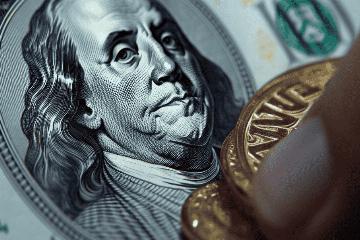Dollar Surges, Stocks Tumble Ahead of Market Open
Advertisements
The financial landscape witnessed considerable fluctuations on February 3, 2025, with the dollar index soaring to remarkable heights, climbing to 109.5—a striking gain of approximately 0.9%. More notably, at around 11 AM Beijing time on the same day, reports surfaced that the dollar index peaked at an impressive 109.7540. Such robust performance of the dollar caught the attention of analysts and investors worldwide, sparking a flurry of discussions regarding its implications for the global economy.
Market analysts have swiftly linked this sudden rise in the dollar index to the recent economic decisions made by the U.SPresident, who enacted an executive order imposing tariffs on a variety of imported goodsInterestingly, the timing of these tariffs coincided with the dollar's ascent, suggesting a direct correlation between governmental fiscal strategies and foreign exchange fluctuations.
On February 1, just two days prior to the dollar's rally, the President formally announced the imposition of a 25% tariff on imports from Canada and Mexico, along with a 10% tariff on products imported from China
Advertisements
Furthermore, he indicated that soon, tariffs would also target European Union products, signaling a fundamental shift in U.Strade policy that aims to protect domestic industries.
This suite of tariffs rippled through the global markets, triggering immediate reactions across Asia and beyondStock exchanges in Japan and South Korea opened to steep declines, with major indexes suffering drops exceeding 2%. Similarly, when the Hong Kong stock market resumed trading post-Lunar New Year celebrations, it faced a cold reception, with the Hang Seng Tech Index diving more than 3%. Even U.Sstock futures reflected this turmoil, with the Nasdaq 100 Index dropping over 2% during morning trading.
Analysts assert that the implemented tariff policies cast a shadow of uncertainty over the international trading landscape, thereby propelling the dollar index higherThe apprehension surrounding increased tariffs has fostered a prevailing sense of risk aversion among investors
Advertisements
Consequently, many opted to redirect their investments towards dollar-denominated assets, effectively elevating demand for the currency and enhancing its exchange rate.
In tandem, the introduction of tariffs translates into higher prices for imported goods, thereby exacerbating inflationary pressures within the United StatesAs expectations for inflation escalated, the currency exchange markets began to price in the possibility of the Federal Reserve postponing any potential interest rate cutsShould inflation remain elevated, the Fed may find itself obliged to sustain current interest rates or defer any reduction in the near term, subsequently intensifying the allure of dollar assets and contributing to the dollar index's impressive short-term ascent.
The reaction witnessed across the foreign exchange market has been pronouncedAs the dollar index surged, non-dollar currencies against the dollar uniformly began to weaken
Advertisements
Major currencies such as the euro, pound, and yen experienced varying degrees of depreciation vis-à-vis the dollar, underscoring the latter's renewed dominance in the global monetary system.
Meanwhile, the Chinese yuan also faced pressure against the dollarDespite a relatively stable economic outlook in China, bolstered by signals from financial authorities reinforcing a commitment to maintaining stability in the exchange rate, the yuan's momentum was undeniably affected by the dollar's robust performance in the wake of the tariff announcements.
However, certain institutions argue that the immediate impacts of the tariff policies may remain manageableExperts from Zhongtai International noted that prior to the announcement, market participants had somewhat anticipated the President's tariff decisions, which means that adjustments in Hong Kong markets had already been incorporated into pricing, and mass sell-offs were not expected to occur.
Nevertheless, the trajectory of the U.S.'s tariff policies towards China remains obscured, necessitating keen observation of subsequent factors—such as consumer sentiment during the Lunar New Year, developments in U.S.-China relations, financial and inflation data from January, and the progress of local government bond issuances—and their effects on market dynamics.
Regarding the amplified dollar index, investor sentiments are notably divided
- Nvidia's $4.2 Trillion Vanish Sparks 3% Plunge in Nasdaq
- Fed Signals Potential Pause in Rate Cuts
- UAE Deepens Cooperation with BRICS Nations
- DeepSeek: A New Era Begins
- Key Drivers Behind New Productive Forces
Some speculate that with ongoing tariff impacts, the strength of the dollar may persist, potentializing long-term repercussions for global financial markets and asset valuationsIn contrast, others voice concerns that the tariff policies could ignite escalated trade conflicts, detrimentally affecting global economic growth, and precipitate potential adjustments in the dollar index moving forward.
In summary, the executive order signed by the President to increase tariffs has ushered in an air of uncertainty across global financial markets, particularly evidenced by the remarkable rise in the dollar indexIt has also raised crucial questions relating to the interplay between U.Strade policies and international economic stability.
In this intricate and ever-evolving global economic landscape, it is imperative that governments and investors remain vigilant regarding the effects of implemented tariff policies, the stance of the Federal Reserve's monetary policy, and the overarching growth trajectory of the global economy

Leave A Comment